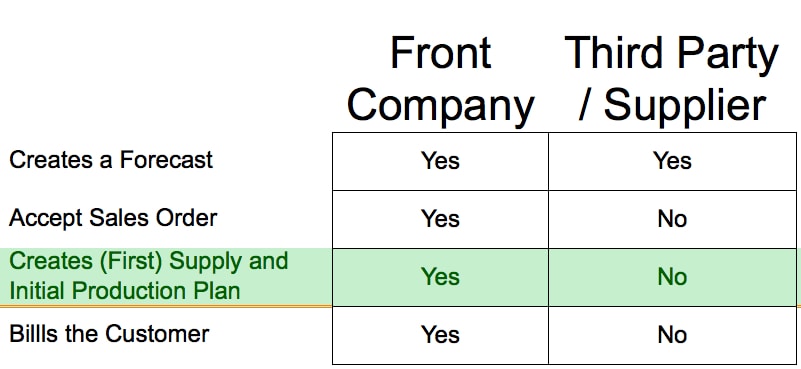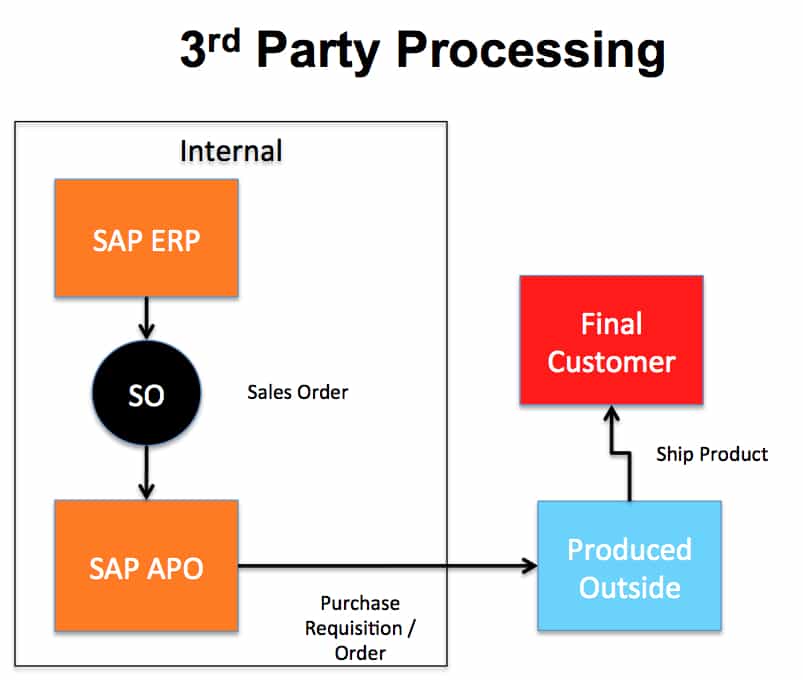Understanding 3rd Party Processing in SAP APO
Executive Summary
- 3rd party processing is how 3rd parties are managed in SAP APO for converting sales orders into an external requisition.
- There are important steps in the configuration process for 3rd party processing.
Introduction
This is the definition of third party processing.
This is the ability of a sales order to be entered in SAP ERP, transmitted to SAP APO as if it is produced externally.
The differences between 3rd party order processing from procurement is the following:
- The product is not fulfilled by the company receiving the sales order.
This means that the company managing this process accepts orders and plans and communicates the demand signal to the third party / i.e., the supplier. The matrix of who does what is the following:

The flow of third party processing looks like the following:

SAP ERP eventually creates a purchase order for it, even though it is planned by APO. SAP has the following to say about 3rd party processing.
“In the SAP Enterprise Resource Planning (SAP ERP) back-end system, when you create the sales order using the item category and corresponding schedule line categories from Customizing, you determine whether or not a sales order item is a third-party item for which planning takes places in the SAP Supply Chain Management system (SAP SCM). You can use a Business Add-In (BAdI) to define customer-specific criteria for which the system checks if external planning should be executed for a third-party item and determines the item category accordingly.” – SAP Help
Sales Orders with Special Schedule Line Category
This means that a sales order with a special schedule line category essentially tells SAP to process the sales order outside of ERP and only in the SAP SCM (APO) system. The following is what happens after a sales order is thus identified.
“The SAP ERP system creates the third-party requisition for planning-relevant items, blocks it, and transfers the data to SAP SCM. Planning then takes place in the SAP Advanced Planning and Optimization component (SAP APO). When the planner releases the third-party order requisition in SAP SCM, the SAP ERP system removes the block so that you can create a purchase order and complete third-party order processing.” – SAP Help
Conversion into a Third Party External Requisition
SAP essentially converts the Sales Order into a third-party (external) requisition. It is blocked from usage in SAP ERP and then transferred for processing to SAP APO. After unblocked, it allows the purchase order to be created in SAP ERP. These items have been activated:
You have activated the following business functions:
- The Outsourced Manufacturing 2 in ERP Operations business function (LOG_MM_OM_2) in SAP ERP
- The SCM APO, Third-Party Order Planning in APO business function (SCM_APO_DRS_PLAN) in SAP SCM
- You have set up an integration model in Core Interface (CIF) to transfer the third-party order requisition data from SAP ERP to SAP APO. – SAP Release Notes
SAP Statements on 3rd Party Order Processing
The release notes say the following on 3rd Party Order Processing.
“Most of the enhancements are executed in CTM with the enhancements in SAP APO and the related enhancements in SAP ERP, supply chain planning for third party orders is now supported. The enhancement provide the following new functions in SAP APO
Forecast consumption for third party requisitions.
A cross location forecast consumption for third party requisitions (which are transferred to the supplier location) and the released forecasts (which are typically available at the distribution centers) is enabled.
Comparison of third party demand and receipt elements (CTM)
This function compares the third-party requisitions (demands) and the planned orders (receipts) assigned to each other via pegging relationships with regard to the following (material availability date of the third party requisition and the material availability date of the latest planned order, the quantity of the third party requisition and the total quantity of the planned orders
For third-party requisitions that meet the requested date and quantity, the supply chain planning can trigger the unblocking in SAP ERP. As a result, the third party purchasing process in SAP ERP can be continued. The third party requisitions that had been blocked in SAP ERP before the planning in SAP APO started, can now be converted into third party purchase orders. In SAP APO the third party requisition gets a special status so that it is not considered in the CTM planning any more
Before activating this business function, ensure the following. You have activated the prerequisite business function Outsourced Manufacturing 2 (LOG_MM_OM_2) for enhancement package 5 for SAP ERP 6.0. Also that you have made the necessary customization settings in SAP ERP for creating third party orders. That you have setup an integration model in the CIF to transfer the third party requisitions from ERP to APO.”
Effects on Existing Data: the area menu has been enhanced by the following new entry.
Advanced Planning and Optimization – > Multilevel Demand and Supply Matching -> Reporting -> Third Party Supply and Demand Comparison
Configuration
This requires the following configuration:
- “Define the item category TPP (third party item with external planning) TAS (third party item) can be copied as a template for this purpose.
- Use the item category group (BTPP – third party item with external planning), which can be copied from the item category group BANS, which can be used as a template.
- Assign item categories SO (Sales Order), BTPP (Third Party Item with External Planning), TAN (Standard Item), TPP (Third Party Item)
- Use the BAdI: Integration of Third Party Order Planning: BAdI can check based upon customer specific criteria if the sales order item or purchase requisition item is a planning relevant third party item. The BAdI also enables you to determine a vendor for the third-party item and material availability date. (In a standard third-party order processing, a vendor does not have to specify for a planning-relevant third party item, however, otherwise, the SAP SCM planning system category manually. When creating the sales order, do not confirm the order until you have entered all the data on the material, quantity, value, and date.)
- Define Schedule Line Categories: (You define a schedule line category. You can use the following default value: Schedule line category D1 (third party item with external planning). You can use the standard schedule line CS as a copy template. Enter the following detailed data: Purchase order type TPP (purchase requisition); you can define the purchase order type in the customizing activity. Define Document Types: See further on: Item category: 5 (third party); a required value. Account assignment category: X (all auxiliary account assignments) External Capacity Planning: Indicator set; required value Incompleteness procedure SD document 31 (schedule line with purchase requisition) Assign Schedule Line Categories (You assign the following schedule line categories to item category TPP Default schedule line category D1 Manually allowed schedule line category CS, Also, you can make the following customization settings under .” – SAP Release Notes
Materials Management – > Purchasing -> Purchase Requisition
How Frequently is 3rd Party Processing Used?
One thing to always be aware of with new functionality is how widely it is being used, or is it used at all.
Therefore, I performed a search in SND.SAP.COM to find out what questions has been asked. This is new functionality, which is a new capability concerning the functionality of 3rd party processing.
I did not find very many questions. One is the following:
“I have a small doubt we are changing item category in 3rd party business processing, what is the exact need of changing item the category?”
There were no answers to this question. I had to rephrase the question as is written by someone, not all familiar with English. Here is another one:
“Can anyone explain me the difference between Movement type and movement type 1 step in VOV6 (Schedule line catg)”
This one also seems to have been written by someone new to English.
There is not much to the answers except one that said that they had configured 3rd party processing without filling in values in this field.
These were the only recent questions posed, which is a concern as it likely means that few companies have tested this new functionality. Looking back to older questions can tell us about 3rd party processing, but it cannot tell us whether the functionality in the most recent APO release (7.1) actually works. This is not encouraging; you never want to be the first person or project to attempt to get some functionality to work.
Conclusion
3rd party processing is an important functionality because the other ways of modeling supplier capacities in APO are very ugly. In the future, I see testing 3rd party processing to see if it works as advertised. Modeling supplier capacity is becoming a more and more frequency requirement, and if 3rd party processing worked, it could be used to allow companies to do this.
References
https://scm.blogspot.com/2007/05/aggregated-planning-in-snp-purpose.html
https://help.sap.com
https://sdn.sap.com